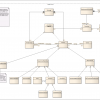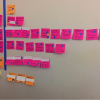 |
Your Strategic Planning Should Be Agile, Too What has agile taught us about trying to plan everything up front? It usually doesn’t work. So why does your company still use a yearly strategic planning approach that takes six months to develop and requires significant time and effort to pivot to new opportunities and challenges? We need to rethink strategic planning to incorporate design thinking, collaboration, and agility.
|
|
 |
Requirements Mapping Using Business Function Test Suites On this team, testers were overcommitted, avoidable defects were surfacing, and documentation was hard to find. Worse, trust and morale were low. Upgrading tools was out of the question, so the testers decided to take matters into their own hands and create incremental change themselves. Here's how a team added a new type of traceability to its requirement test case world.
|
|
 |
The Value of Test-Driven Development when Writing Changeable Code Writing changeable code makes it easier and more cost-effective to add features to existing software. Writing changeable code doesn’t take longer, but it does require paying attention to certain things when building a system. It's important to have a good suite of unit tests that support refactoring code when needed, and test-driven development helps you create independently testable code.
|
|
 |
5 Overlooked Opportunities in Agile Estimation Agile story estimation gives the team insight into the level of effort for each work item, allows the team to assess each requirement’s relative priority, and lets the team refine and clarify story items. But there are even more benefits that can be gained from the estimation process. Try to take advantage of these five opportunities for growth when your team is estimating stories.
|
|
 |
DevSecOps: Incorporate Security into DevOps to Reduce Software Risk DevSecOps is a growing movement to incorporate security into DevOps practices in order to ensure flaws and weaknesses are exposed early on through monitoring, assessment, and analysis, so remediation can be implemented far earlier than traditional efforts. By failing fast with security testing, organizations reduce risk of a security incident and decrease the cost of rework.
|
|
 |
The Ideal Workspace for an Agile Team If your agile team is all wearing noise-canceling headphones and stepping outside for conference calls, you have a problem. An agile workspace doesn't only mean putting everyone in the same room. The layout, configuration, and seating must be conducive to sustainable teamwork. Here are some tips about what an agile workspace is—and isn't.
|
|
 |
Fitting Technical Writing into Agile Development As teams strive to move to a mature agile process, technical writers must adapt as effectively as the development personnel. This new agile process demands that knowledge dealing with software or product releases is only sparingly documented up front, making the technical writer's job of gathering information much more dependent on talking with people over reading requirements.
|
|
 |
Document Why as Well as What: Finding the Purpose of Your Software Code can express what we want to accomplish, but it’s a little more difficult to express why we’re doing something in the first place. The people who maintain code are often not those who originally wrote it, so documenting why helps set a context and gives clues as to what the author was thinking when they came up with a particular design, making developers' jobs easier.
|
|
 |
Using Sprints for Agile Coaching Discussing the work to be done as a group, building in short iterations, getting feedback, and looking for ways to improve are not just practices for development teams—it is an effective way to achieve any goal. Here, Ben Kopel details his experience of working with other agile coaches in a sprint to hire a new ScrumMaster.
|
|
 |
Using Agile to Lead Your Agile Transformation There's something ironic about starting an agile transformation by spending six months creating a detailed transformation plan. We have to move away from a prescriptive playbook and toward a more responsive transformation model. Why not use the agile transformation as your first opportunity to be agile?
|
|

